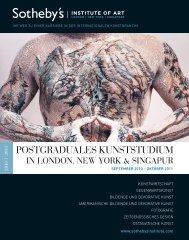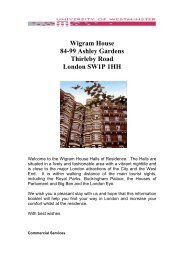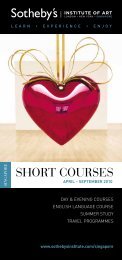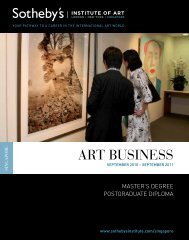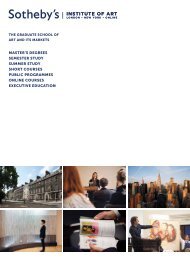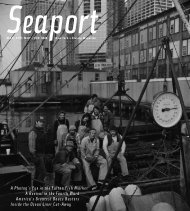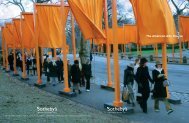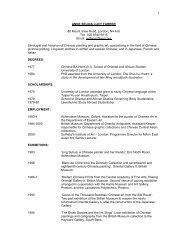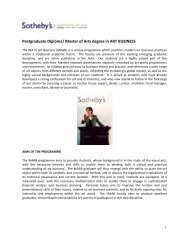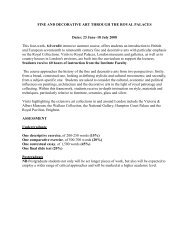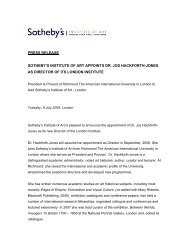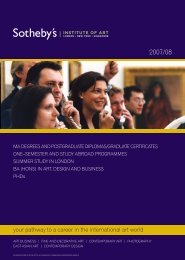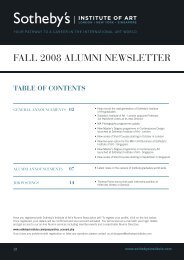Zones of Indistinction: Giorgio Agamben's Bare Life and
Zones of Indistinction: Giorgio Agamben's Bare Life and
Zones of Indistinction: Giorgio Agamben's Bare Life and
You also want an ePaper? Increase the reach of your titles
YUMPU automatically turns print PDFs into web optimized ePapers that Google loves.
CTTE_A_384228.fm Page 118 Sunday, April 26, 2009 1:30 PM<br />
118<br />
over inmates there:<br />
‘Basically, it was over the<br />
president’s opinion, which<br />
owed a great deal to that <strong>of</strong><br />
vice-president Dick Cheney<br />
<strong>and</strong> Cheney’s chief-<strong>of</strong>-staff<br />
David Addington, that the<br />
primary duty <strong>of</strong> the<br />
executive branch is to<br />
defend the national<br />
security <strong>of</strong> the state at<br />
whatever cost. That this<br />
opinion may be sincerely<br />
held is beside the point;<br />
that it partakes more <strong>of</strong><br />
autocracy than <strong>of</strong><br />
democracy is beyond<br />
doubt. In this it represents<br />
a considerable departure<br />
from the thinking <strong>of</strong><br />
America’s “founding<br />
fathers”, but comes close in<br />
some ways to that <strong>of</strong> Carl<br />
Schmitt, the influential<br />
German jurist who<br />
furnished the philosophical<br />
basis for the Nazi regime.’<br />
Peter Weiss, ‘Boumediene<br />
v. Bush: Guantánamo <strong>and</strong><br />
Justice’, Open Democracy,<br />
available at http://<br />
www.opendemocracy.net/<br />
article/boumediene-v-bushguantanamo-<strong>and</strong>-justice-0<br />
(accessed 26 June 2008).<br />
16 At the time <strong>of</strong> writing the<br />
Supreme Court <strong>of</strong> the<br />
United States ruled by a 5–<br />
4 majority on 12 June<br />
2008 in favour <strong>of</strong> a case<br />
brought on behalf <strong>of</strong><br />
detainees held at<br />
Guantánamo. The ruling<br />
was as follows: those<br />
incarcerated in<br />
Guantánamo have full<br />
rights <strong>of</strong> habeas corpus<br />
under the US constitution.<br />
This follows a number <strong>of</strong><br />
similar rulings that have<br />
dogged the Bush<br />
government’s attempts to<br />
have these trials held in<br />
military courts.<br />
17 In Torture Team:<br />
Deception, Cruelty <strong>and</strong> the<br />
Compromise <strong>of</strong> Law,<br />
Philippe S<strong>and</strong>s clarifies a<br />
number <strong>of</strong> issues in relation<br />
to recent debates regarding<br />
Guantánamo Bay <strong>and</strong> Abu<br />
Ghraib. First, <strong>and</strong> despite<br />
opposing assertions from<br />
the Bush government, S<strong>and</strong><br />
argues that the ‘illegitimate’<br />
torture techniques used in<br />
Abu Ghraib can be traced<br />
to the so-called ‘legitimate’<br />
interrogation techniques<br />
a military to a cultural base, the artists displayed treaties <strong>and</strong> documents<br />
to expose what they viewed as the illegitimacy <strong>of</strong> the US lease contract<br />
imposed on Cuba in 1903. They also displayed forty-seven annual rent<br />
cheques – all <strong>of</strong> which the Republic <strong>of</strong> Cuba has refused to cash – that<br />
have been issued by the United States to the Cuban Government since<br />
1959. At the time <strong>of</strong> writing, Guantánamo Bay, that most conspicuous<br />
<strong>of</strong> indistinct zones, still housed 270 detainees <strong>of</strong> whom only nineteen had<br />
been formally charged.<br />
Guantánamo Bay may be the most obvious ‘zone <strong>of</strong> indistinction’<br />
Omar D, Devoir de Mémoire/A Biography <strong>of</strong> Disappearance, Algeria 1992 . Courtesy <strong>of</strong> Autograph ABP<br />
where the banished figure <strong>of</strong> modern-day homo sacer languishes in an<br />
interstitial space wherein legality <strong>and</strong> illegality, legitimate interrogation<br />
techniques <strong>and</strong> outright torture, unlawful <strong>and</strong> lawful enemy combatant,<br />
the rule <strong>of</strong> law <strong>and</strong> its suspension <strong>and</strong> life <strong>and</strong> death become strategically<br />
blurred. 17 However, such zones do not necessarily have to have a localised<br />
topography <strong>and</strong> can be national in their scope. We could highlight<br />
here the 6000 plus disappeared <strong>and</strong> tortured since the onset <strong>of</strong> civil war<br />
in 1992, many <strong>of</strong> them at the h<strong>and</strong>s <strong>of</strong> the security forces, in the ongoing<br />
political tragedy that is modern-day Algeria. In Algeria a ‘state <strong>of</strong> emergency’<br />
has become the rule. In Algerian-born Omar D’s photographs <strong>of</strong><br />
the disappeared, we encounter images not only <strong>of</strong> the disappeared but<br />
also <strong>of</strong> what they have left behind. 18 One <strong>of</strong> the more common refrains<br />
from those relatives <strong>and</strong> friends left behind is that they do not know<br />
whether the disappeared are alive or dead. Again, the blurring <strong>of</strong> life<br />
<strong>and</strong> death is seen to be connected to the manifestation <strong>and</strong> effect <strong>of</strong> a<br />
‘zone <strong>of</strong> indistinction’; an extra-legal space wherein which citizenship<br />
can be blurred into ‘bare life’ <strong>and</strong> life itself into death. Elsewhere, in the<br />
mid-1990s, the Argentinian photographer Marcelo Brodsky returned to<br />
his homel<strong>and</strong> equipped with his camera <strong>and</strong> a 1967 photograph <strong>of</strong> his<br />
eighth-grade classmates. In Buena Memoria, 1996, Brodsky enlarged the<br />
photograph <strong>and</strong> annotated it, noting in turn where his classmates had<br />
ended up. Whilst some had married <strong>and</strong> some had gone into exile two<br />
members <strong>of</strong> the class had been ‘disappeared’. In this act <strong>of</strong> tapping into<br />
collective memory Brodsky brings to the fore the role <strong>of</strong> photography in<br />
addressing that which is now absent; the moment when that which no<br />
longer exists as anything but trauma can be nonetheless reified in visual<br />
culture. Drawing on the troubled past <strong>of</strong> Colombia, Oscar Muñoz’s<br />
video ‘Proyecto para un memorial (Project for a Memorial)’ (2005)<br />
shows the artist h<strong>and</strong> painting portraits <strong>of</strong> disappeared people on a<br />
concrete sidewalk. Instead <strong>of</strong> paint, however, he uses water, which evaporates<br />
before each portrait is fully realised. Aesthetically, in the very<br />
form being used, Muñoz’s water-paintings become a metaphor for the<br />
disappeared <strong>of</strong> his native country.<br />
In all <strong>of</strong> the above instances, artists have used their practice to examine<br />
the very moment when states turn on their people <strong>and</strong>, in so-called<br />
states <strong>of</strong> emergency, set about terrorising their own citizens. In all three<br />
instances martial law <strong>and</strong> states <strong>of</strong> emergency were declared <strong>and</strong> individual’s<br />
were outlawed to ‘zones <strong>of</strong> indistinction’ – detainment camps,<br />
holding cells, torture chambers – where their recourse to the law was not<br />
only suspended but the political legitimacy <strong>of</strong> their lives brought to its<br />
fatal conclusion. We could continue here with a depressing litany <strong>of</strong><br />
countries from as far afield as Chile, the one-time USSR <strong>and</strong> fascist<br />
Spain, all <strong>of</strong> which wanted, to use the nomenclature <strong>of</strong> Nazi Germany,



